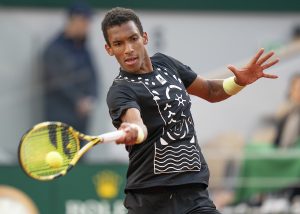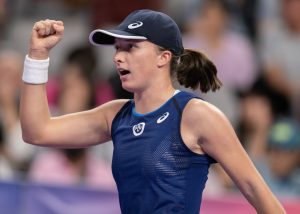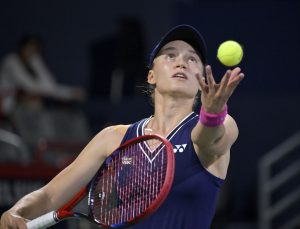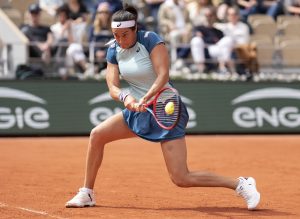Tomas Martin Etcheverry had every reason to have an early exit in this past week’s Cordenons Challenger. He had just won the title in Trieste the week before, the second Challenger title of his career. His first Challenger singles title wasn’t too long ago either–he won the Perugia Challenger in July in his maiden run.
Faced with a tough draw on the physically-demanding red clay, it would have been easy for Etcheverry to phone it in.
He did anything but that.
While Etcheverry’s Cordenons campaign ultimately ended in a straight sets defeat to Francisco Cerundolo in the final, it was an admirable week for a player who fans might not see on the Challenger Tour much longer.
Recent Success for Tomas Martin Etcheverry
Etcheverry’s journey to this point had been gaining traction for some time. He had slowly been establishing himself this season as a force to be reckoned with on the red clay. Over the first six months of the year, the Argentinian made four clay-court Challenger semifinals, He even sprinkled in a couples ATP Tour victories, advancing past the first round in Cordoba and Santiago during the Golden Swing.
Having made his first Challenger final late in 2020, a loss to Marc-Andrea Huesler on the red clay of Sibiu, it seemed as though Etcheverry was slowly progressing towards becoming a great clay player.
Etcheverry’s forehand was becoming more potent, his backhand more stable, and he was doing a better-and-better job of controlling the baseline and taking the initiative in rallies.
But, in Perugia, his forehand seemed to take off to another level, one rarely seen on the ATP Challenger Tour. Etcheverry ran through tough opponents such as Dominic Stricker and Salvatore Caruso before beating Vitaliy Sachko in the final, 7-5 6-2.
Even a veteran like Caruso, with a career-high ranking of World No. 76, couldn’t seem to figure out a way to blunt the sheer force of the Etcheverry forehand. Etcheverry made the Italian look devoid of weapons and forced him to just look for a way to keep the points alive, rather than take control.
After yet another Challenger final on the clay of Todi, Etcheverry won the title in Trieste. He only dropped one set all week, to former World No. 33 Robin Haase. He lost only two games in the final, dominating Thiago Tirante 6-1 6-1. Tirante is a player that relies on heavy, powerful forehands to control the baseline, yet found himself in completely defensive positions for most of the match, as Etcheverry’s forehand and overall baseline game were just at another level during the match (and at this stage of their careers).
Etcheverry held every opponent in Trieste to 60%-or-less first serves won and under 55% second serves won. In the final, Tirante only won 42% of points on his serve!
Etcheverry in Cordenons
Yet, two days later, Etcheverry found himself back on the clay for yet another Italian Challenger. Playing a consistent, wily opponent in Renzo Olivo, it was going to be a physical challenge for Etcheverry to perform at the level necessary to advance.
And, it was quite the battle, both physically and mentally. In a nearly-three-and-a-half-hour, three-set match, Etcheverry somehow found the physical and mental strength needed to win 5-7 7-6(3) 7-5.
Etcheverry went down a break in the second and third sets. The third set alone lasting nearly an hour-and-a-half. Olivo threw everything he had at Etcheverry, utilizing different spins, angles, depths, and good consistency. Yet, it wasn’t enough, as Etcheverry ultimately found enough forehands to make Olivo’s life miserable and force Olivo into very defensive positions.
And, ultimately, this put enough wear-and-tear on Olivo that he couldn’t keep up the level of play necessary to succeed.
In his next match, despite taking a medical time out, Etcheverry had an easy time with Federico Gaio. Etcheverry’s strategy of standing far out-wide on his first serve to the ad-side, then serving heavy firsts at a sharp angle to right-handed players’ backhands, thereby producing an error or opening up the court for an easy forehand-up-the-line when the player inevitably tries to force the ball into Etcheverry’s backhand.
Gaio’s backhand could not handle the Etcheverry serve or forehand in this match, as he was helpless, just hoping for a significant drop in Etcheverry’s level. That drop didn’t come, as the Argentinian won 89% of his first-serve points and had a much-needed comfortable victory over Gaio.
In the quarterfinals, Etcheverry had to navigate another three-set match. Taking on Juan Pablo Varillas, it was yet another battle-of-the-big-forehands as Etcheverry and Varillas tried to subtly position themselves in the court to have their forehand be the one to control the baseline.
Ultimately, it was Etcheverry whose groundstrokes were just a little bit more reliable and who could do a little bit more on the serve when it mattered on his way to a 6-2, 2-6, 7-5 win over Varillas. During the match as-a-whole, Etcheverry won 63% of his first serves and 48% of his second serves, while Varillas won 64% of his first serves and 46% of his second serves. But, in the third set Etcheverry won 71% of his first serves and 55% of his second serves, compared to Varillas only winning 56% of his first serves and 50% of his second serves.
The semifinals in Cordenons was yet another tough test for Etcheverry, who had to play the big-hitting lefty Marc-Andrea Huesler, the player who stopped Etcheverry from winning the Sibiu Challenger nearly a year prior.
This time, Etcheverry got the upper-hand. Etcheverry took down Huesler 6-3 1-6 6-3, winning 78% of his first serves while putting 69% of his first serves in. Given the physical and mental fatigue that was clearly affecting Etcheverry at this point, as well, it was an incredible effort. Etcheverry looked physically exhausted, seemed to have picked up some injury, and was playing a hard-hitting lefty who could effectively get the ball into Etcheverry’s backhand.
Yet, it ultimately didn’t matter. In the third set, Etcheverry only lost six points on his serve and took advantage of a brief dip in Huesler’s level to snag the victory out of the Swiss’ hands.
But, like anything in life, all good things have to come to an end. As mentioned previously, Francisco Cerundolo and his huge forehand proved to be too much for a weary Etcheverry, with Cerundolo winning 6-1 6-2 to take the title. The footwork wasn’t there for Etcheverry and it seemed like he was slapping at his groundstrokes much more than he typically does.
Yet, the final game of the match was a testament to the fighting spirit that Etcheverry had shown all week. Etcheverry was still mentally engaged, firing himself up, going for his shots and not allowing his intensity to slip one iota.
In a topsy-turvy, 18-point game, Etcheverry used every last bit of energy as he desperately tried to find a way back into the match. And, while it ultimately wasn’t enough, that game was a testament to Etcheverry’s “never say die” attitude. Bravo.
Etcheverry was at a career-high ranking of World No. 148 coming into this week, and he will rise further when the new rankings come out tomorrow, as he’s currently World No. 139 in the live rankings.
Given Etcheverry’s ATP Tour-level forehand in terms of depth and controlled aggression, along with his ability to hit into small windows with incredible precision, there’s no doubt that he will be in the Top 100 soon.
While Etcheverry hasn’t played on grass much, he is not exclusively a clay-court player. Through the course of his career, the Argentinian has a 68% winning percentage on clay, but his hard court winning percentage over the course of his career is nothing to scoff at.
Etcheverry has won 61% of his hard court matches (although the sample size is smaller) and he even lists hard courts as his preferred surface! So, it will be very interesting to see how Etcheverry does in US Open qualifying.
But, that’s something for Tomas Martin Etcheverry to worry about in the future. For now, he should just be proud of himself for his physical and mental fortitude in Cordenons.
Main Photo:
Embed from Getty Images






